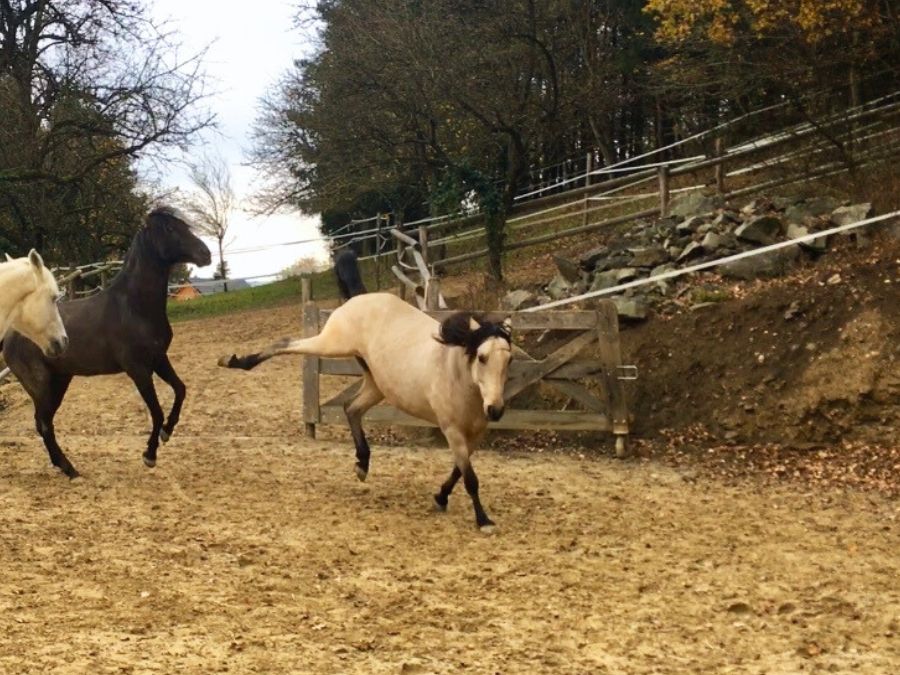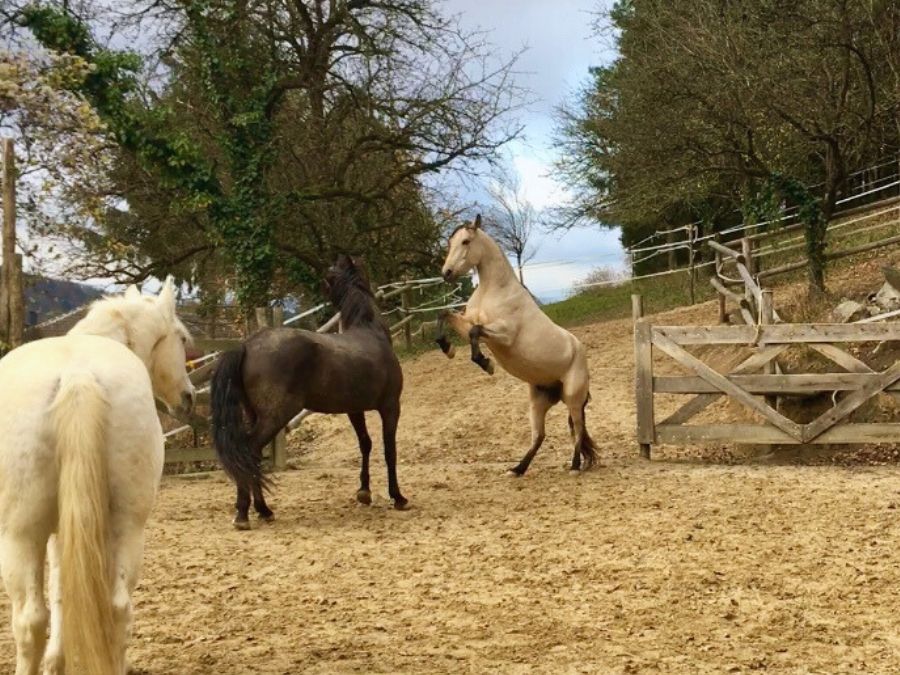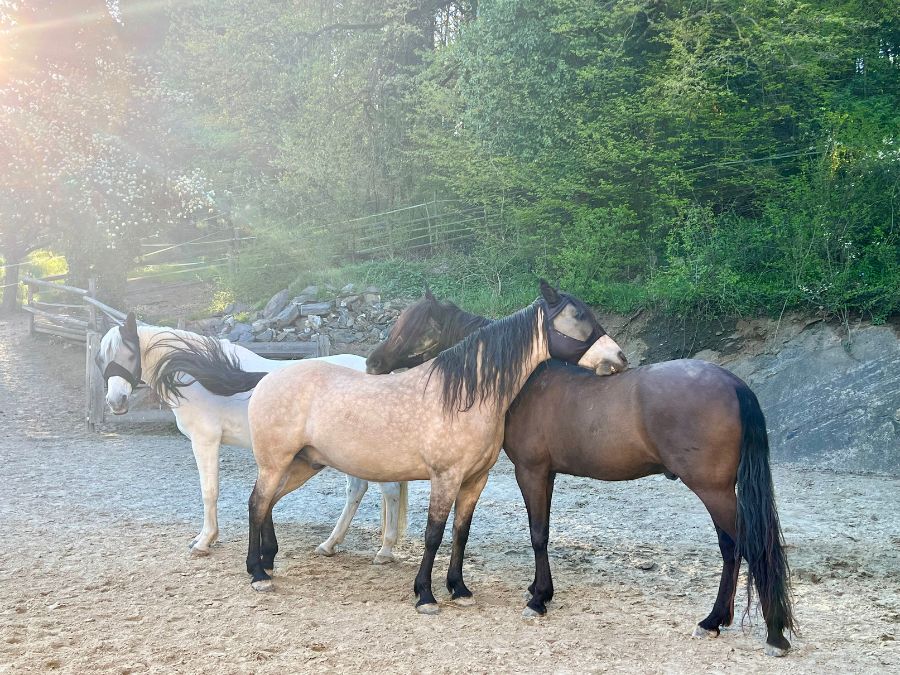
Horses communicate their boundaries clearly
nd thus find security in the herd structure and in their rank. Only as much as necessary and usually without touching them at all.
Of course, you can start by asking yourself whether it is ethically correct to make horses do anything at all. Everyone can only answer this question for themselves. Personally, I answered it some time ago with “Yes, if…” and try to give my horses a good life that allows them to grow much older than they would in the wild. I also think riding is justifiable as long as the horses emerge from the cooperation as braver, stronger, happier and more relaxed. Unfortunately, horse training is still often based on coercion instead of clarity and natural leadership qualities (such as patience, calmness, reliability, comprehensible actions, fairness, acting in accordance with the situation, etc.).
A person who sends unclear signals with their body language unsettles a horse and makes it jumpy (some horses also become aggressive). A person who uses force makes a horse turn in on itself (dead eyes) or revolt (so-called rebelliousness). Coercion is defined as using threats or excessive force to get someone to do something – I would add: Boundaries of dignity are crossed here and what is left behind for the horse is a feeling of humiliation. In my opinion, force is always mistakenly used by riders when one or more of the basic building blocks of training (balance, carrying capacity, communication language, trust, etc.) are still missing (about which, again, there is often ignorance) or the person is driven by selfish interests.How wonderful that you never actually have to force yourself when working with horses if you are prepared to deal with yourself and take the time to take one step at a time and adapt the pace of training to the horse. An exception would perhaps be if you are in mortal danger because the horse is about to gallop towards a busy road. Then, if necessary, I would do everything I could to make it stop. Thankfully, however, with lovingly and finely trained horses, you practically never get into this situation.

Regularly testing boundaries is also a natural behavior
that you don’t have to get angry about, but rather serves to strengthen the horse’s own sense of security within the herd structure. The dun is playfully asking the higher-ranking bay: Are you still fit to protect us from danger anyway?
At this point I would also like to make a comment: anyone who works according to natural horsemanship and repeatedly forces a horse during training, blunts it mindlessly with objects or breaks it to the point of total lack of will has misunderstood something very fundamental about natural or horsemanship. This is submission by force and not finely dosed communication as horses do with each other. The horse’s comfort zone should always be extended by working with a human, not reduced.
An example: Suppose a horse is afraid of a large construction machine on the side of the road. Forcing the horse would be to make it even more afraid (e.g. by hitting it and building up pressure) than it is of the construction machine. In the end, most horses (depending on their level of panic) will be intimidated by this and allow themselves to be forced past the construction machine. Unfortunately, how often do you hear the words “Drive him past, he won’t take you seriously!”. However, I would like to advocate a different approach here, which is much more sustainable. First, formulate a clear inner image: “The construction machine is our friend.”. Of course, I have to feel and radiate this authentically, which brings us to natural leadership qualities. Because if I’m not sure whether the construction machine is our friend, I should check again exactly what is actually unsettling me. The same applies if you want to ride an exercise and you’re not sure whether it’s right/healthy etc. for the horse. Then I have to deal with my own uncertainties first, anything else would be unfair, because horses sense ambivalence precisely. Back to the example with the construction machine. Next, I imagine the horse calmly and serenely walking past it in my mind’s eye. Even if this is not yet the case at all – this is perhaps the most difficult part of this approach. Now I start a verbal whispering (encouraging words) or body language (encouraging gestures) dialog with the horse. To do this, I use a rope or a whip to extend my body axis (people are tall – horses are long), but only to nudge the horse very lightly. Just as much as a horse’s nose would perhaps do from behind – a tactile encouragement, not a blow. So I ask it how far it dares to go sideways, but only ever so far without the horse being overwhelmed or stressed. No mammalian brain can learn under acute stress! If the horse gets scared, I as the trainer have done something wrong and have to change the situation so that the horse is stimulated by the new situation but no longer stressed. Then I wait at this point until the horse is really deeply relaxed – only then do I go one step further.

Horses cultivate deep friendships
when the herd and husbandry are optimal for the individual.
This may take a little longer than forcing the horse to pass quickly (but sometimes even shorter!), but in the end I have probably even gained trust points and kept a friend. And what’s more, a friend who now has less to fear in our human world (in which there are many scary devices). In the end, you can clearly see the difference in the horse’s eyes which way you have worked. Because a horse that has been given clarity and security by humans has a satisfied, self-confident expression.

